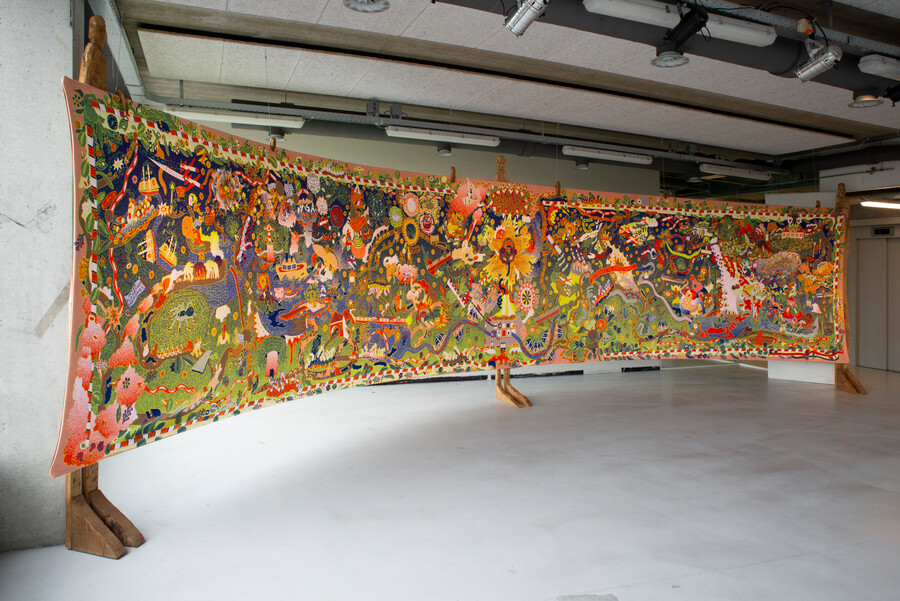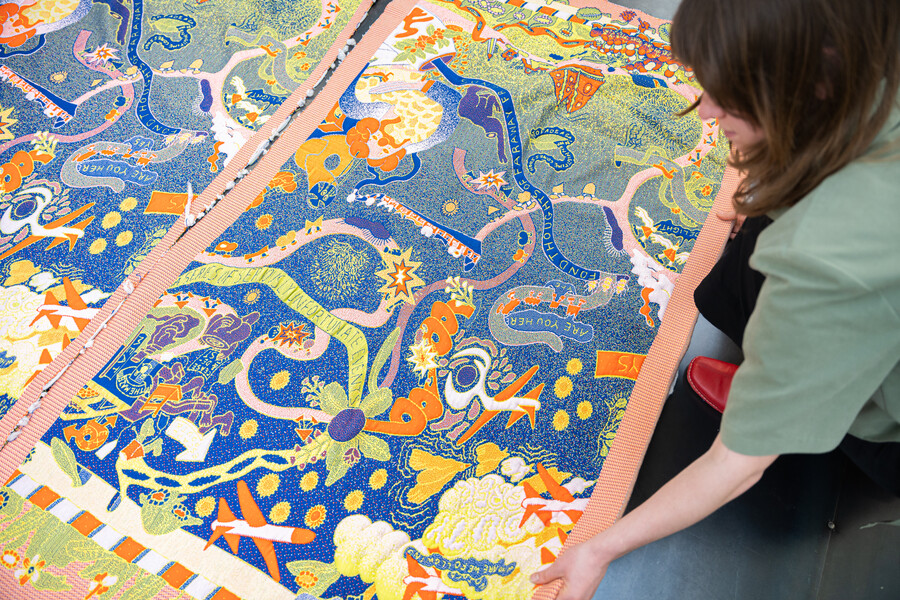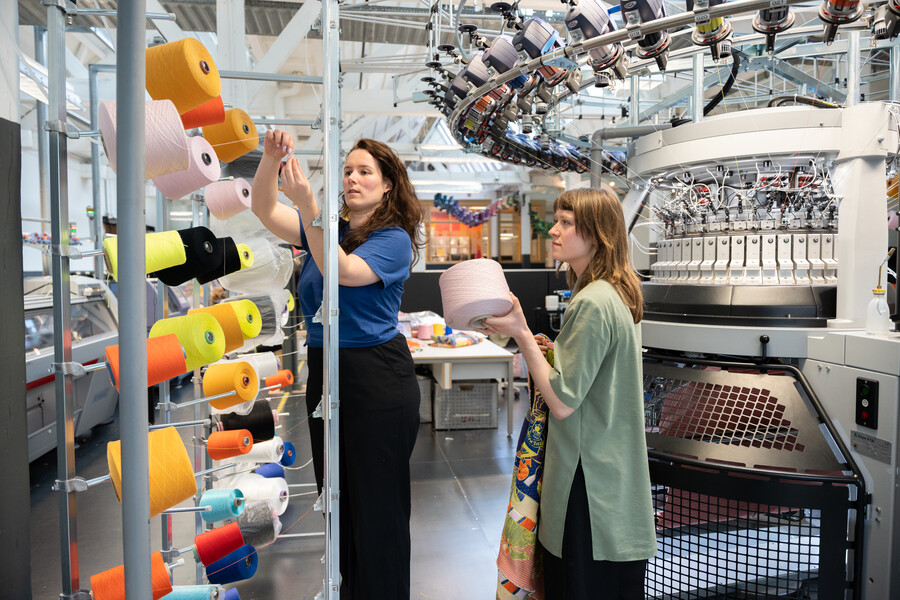Among the standout pieces in the Secrets of making #4 exhibition is Fanja Bouts’ gigantic, knitted tapestry, which she made in the lab with Mathilde Vandenbussche for her graduation project. Her cartoonish drawing style translates so well into textiles that she is returning for a second project.
While studying physics and astronomy at the University of Amsterdam, Fanja Bouts also joined the Rietveld Academy. Following those two bachelor’s degrees, she is now doing a master’s in environmental sciences in Wageningen. She also has her own vegan catering company, and she is an illustrator. Drawing is a way for her to express herself – in between all her other activities. In the process, she creates entire cartoon stories, using humour and satire to show the damage humans are doing to the planet. “It would be great if I could have a positive impact through my work, even if it is only small.”
Eye-catcher
Bouts may have her wish. Her spectacular graduation piece has not gone unnoticed. It was awarded the 2023 Public Choice Award by Galerie Ron Mandos and has attracted considerable media attention. The 10-metre-long knitted tapestry has an equally long title: ‘A Largely Distorted yet Surprisingly Ordered Map of Regular Irregularities: A Dense Description of The Present Day History of The Future’. The explosion of colourful figures, planets, buildings and eccentric creatures initially looks like a cheerful picture puzzle. Zoom in, however, and you will see an indictment of our insatiable hunger for more, with references to factory farming, monoculture, the effect of pesticides and the capitalist system that underpins it all. The big bang in the centre shows an ATM and the words ‘In money we trust’: we are born into a capitalist system largely driven by money.

Photo: Simon Pillaud

Photo: Josefina Eikenaar
“I really enjoyed sparring creatively with someone about the work.”
Fanja Bouts
Charcoal drawing
The fact that this contradictory universe has become a knitted work was not planned. “I fell into it almost by accident,” says Bouts. It all started with a charcoal drawing on canvas, which she showed to her teacher at the Rietveld Academy. He saw a tapestry in the image and advised her to consider the TextielLab. At the last minute, Bouts applied for one of the lab slots reserved for graduating students and submitted a sketch for a woven textile. “Then I got a call: the lab wanted to make it, but on the circular knitting machine.” That not only required some rethinking but also a significant revision of the sketch to make it suitable for the different format. Fortunately, product developer Mathilde Vandenbussche was on hand to help. “It’s fascinating to see what Mathilde can do with that machine. I often work alone. I had never sparred creatively with someone like that before, and I really enjoyed it. I also like how dependent you are on the thread. The result is a constant surprise.”
New double cloth technique
As the metres-long drawing was too heavy for the circular knitting machine’s memory, the project was knitted in sections. This meant that the different parts of the drawing had to match seamlessly. In addition, a new double cloth technique was applied in which the four colours in the work can be used freely. The lab’s previous circular knitting machine was less able to do this. The result is a surprising image that almost appears woven. Three copies of the work were produced. One was sold and the second is currently on display in Secrets of making #4 in the TextielMuseum, along with samples and sketches from the development process. A legend was also added explaining the image’s texts and symbols. It was designed by Daniel García Muñoz who will graduate from the Rietveld Academy this year. The third fabric will be on display from September near Barcelona, Spain, at the 15th Manifesta biennial.

Photo: Patty van den Elshout
“It’s an endless journey of discovery.”
Fanja Bouts
Airport tapestry
The international attention that the tapestry has received has attracted new clients. This summer, Bouts will start designing a new work for Dutch Customs, for the Government of the Netherlands collection. “I have now seen how well my cartoonish drawing style and texts translate into textiles, which makes sense: throughout history, tapestries have told stories with different perspectives. Wall hangings are also practical. They are soft, provide warmth, improve acoustics, and you can roll them up and carry them under your arm.” The new tapestry, which will be woven this time, is intended for the new cargo building at Schiphol Airport. With a floor area of 61,000 square metres, it will be one of the largest airport logistics buildings in the world. To develop the design, which will once again be a cartoon with a critical slant, Bouts will interview various employees about their daily work. “Given the location, I will obviously include a climate message, but I’ll convey it with humour.”
Journey of discovery
The Schiphol tapestry is due to go into production in October, when Bouts and product developer Lotte van Dijk will experiment with different weaves and the structures they create. “When I was working on my graduation project, I went into the process blind. I now know a little more than I did. Even so, I’ve opted for another new technique. It’s an endless journey of discovery. I had no idea in advance how any of this would turn out, but textiles have really grabbed me.”

Photo: Patty van den Elshout
Text: Willemijn de Jonge